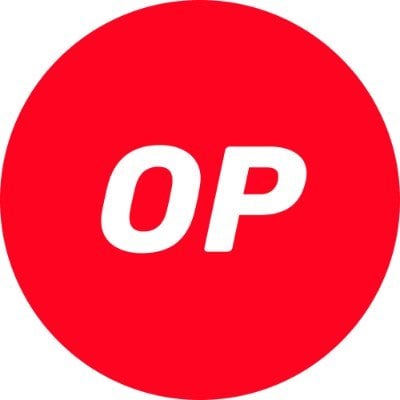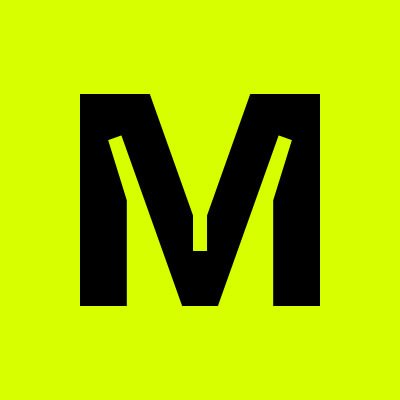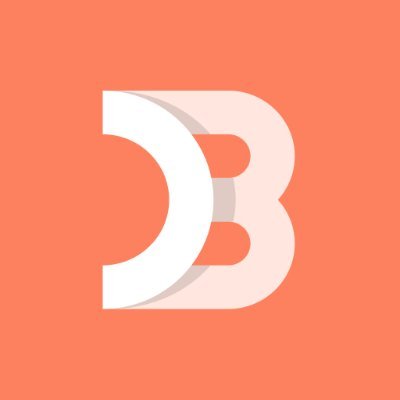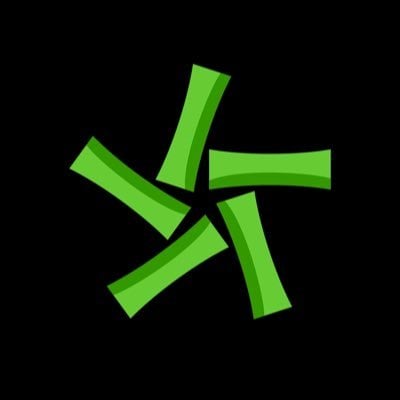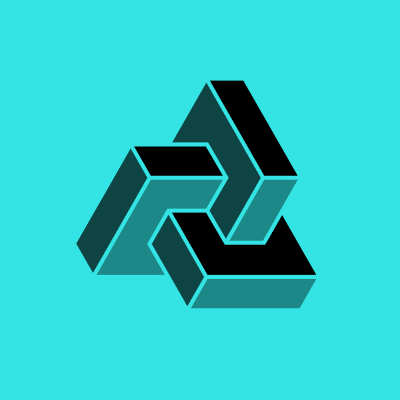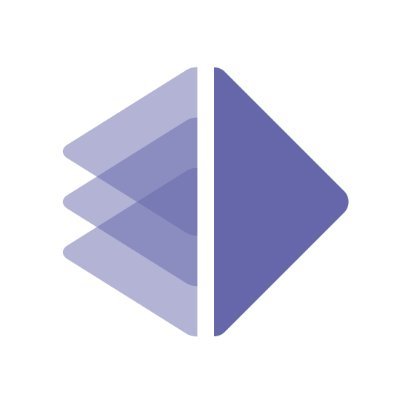Binance Research: Exploration of the OP Stack Ecosystem and Super Chain
Original Title: The OP Stack: What's New?
Original Author: Shivam Sharma, Binance Research
Compiled by: Huo Huo, Baihua Blockchain
The era of L2 Rollups is approaching, with activity on Ethereum L2 reaching an all-time high. The average transactions per second ("TPS") on L2 have surpassed Ethereum since the end of 2022.
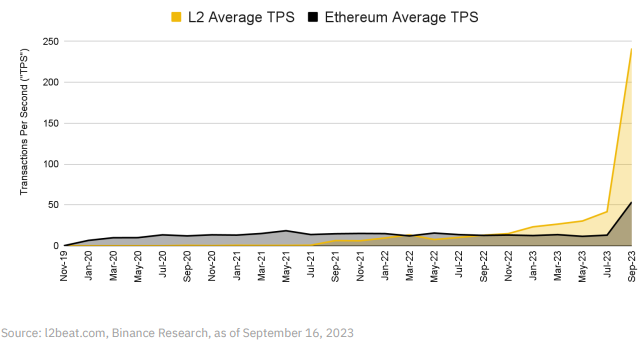
In the latest wave of L2 releases, many have utilized the OP Stack, an open-source software development stack that supports Ethereum L2, the OP mainnet, and new participants like Base and Zora Network. Optimism envisions a future where these Rollups are combined with numerous others to form a decentralized L2 chain network, known as the Superchain.
This article delves into the OP Stack and Superchain theory, then explores the evolving OP Stack ecosystem, including Base, Zora Network, DeBank Chain, and more. Additionally, it discusses infrastructure solutions that enable developers and builders from various backgrounds to access this series of OP Stack chains.
About Optimism
Optimism is the company behind the OP mainnet, which is an Optimism Rollup similar to the Ethereum Virtual Machine ("EVM") and has been operational since 2021, making it one of the leading Ethereum Layer 2 solutions. As of the writing of this report, the total value locked ("TVL") in the OP mainnet exceeds $2.6 billion, holding the second-largest market cap among all Ethereum Layer 2 solutions, with a market share of over 25%.
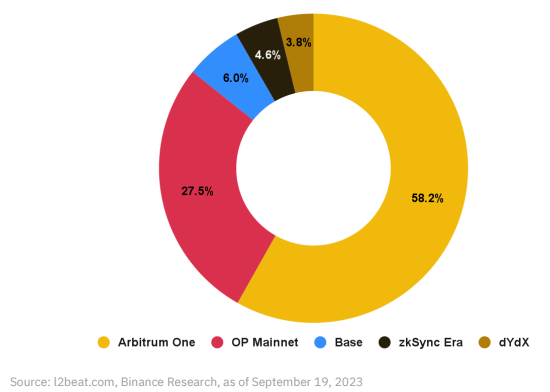
In October 2022, Optimism introduced the OP Stack, described as "highly scalable and highly interoperable modular open-source blueprints." It also introduced the concept of the "Superchain," referring to a highly integrated and unified group of Layer 2 blockchains built on the OP Stack. The next major development is the migration of their L2 Rollup to Bedrock.
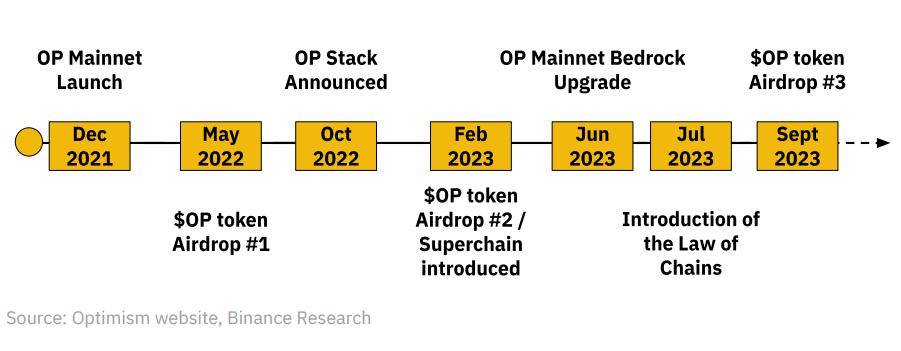
Brief Timeline of Optimism's Development
The OP Stack is a standardized, shared, and open-source development stack that supports the OP mainnet, composed of various software components that build Optimism's L2 Rollup, aimed at creating a shared, interoperable, and collaborative L2 blockchain network. The OP Stack is designed to simplify the construction of L2 blockchains, akin to a "supermarket for building L2," allowing builders to easily modify or create modules to meet their specific needs.
Builders can modify existing modules or create new ones to suit their requirements, as the OP Stack deconstructs and packages different components for building L2 into independent modules. Ultimately, Optimism expects highly compatible L2s, referred to as OP Chains, to form part of a Superchain.
The Superchain theory is Optimism's vision to upgrade its ecosystem into a Superchain. The Superchain is envisioned as a decentralized network of L2 chains (OP Chains) that share security, a communication layer, and an open-source technology stack (OP Stack). These chains will be standardized to serve as interchangeable resources to enhance chain interoperability.
This standardization will enable builders to create applications targeting the entire Superchain, rather than just applications running on the underlying chains. It is important to note that the Superchain is still a concept and is continually being refined.
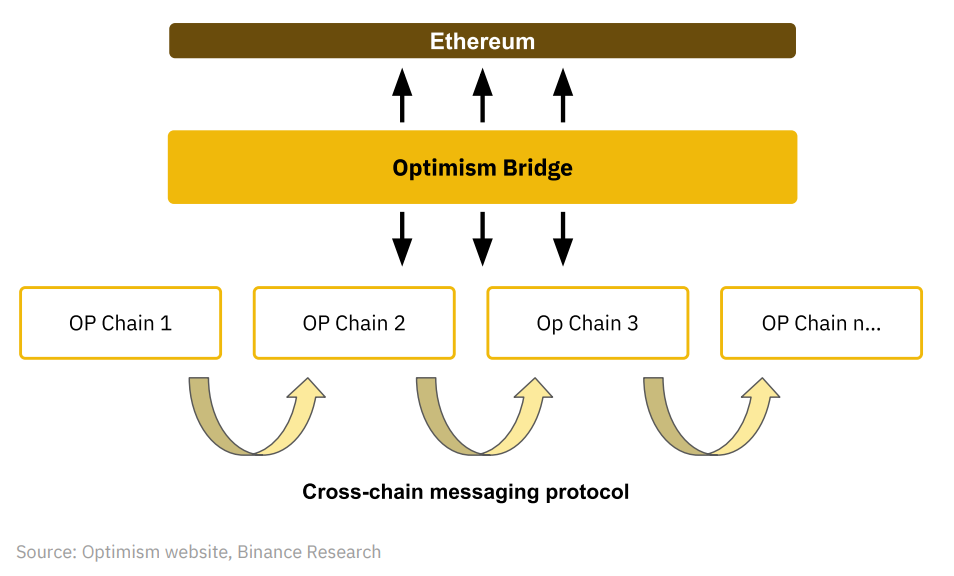
Superchain Diagram
The Growing OP Stack Ecosystem
Since the release of Bedrock in June 2023, we have seen many Rollups based on the OP Stack. Next, we will take a closer look at some of the star projects and major infrastructure projects.
A quick glance at the table below shows that Base's development is far ahead. In fact, the cumulative unique address count for Base is even higher than that of the OP mainnet. The Onchain Summer activity and integration with Coinbase for user access may be key reasons for these relatively high numbers.
Please note that only the OP mainnet, Base, Zora Network, and Public Goods Network are on the mainnet, while the other three projects we cover are still in testing phases.
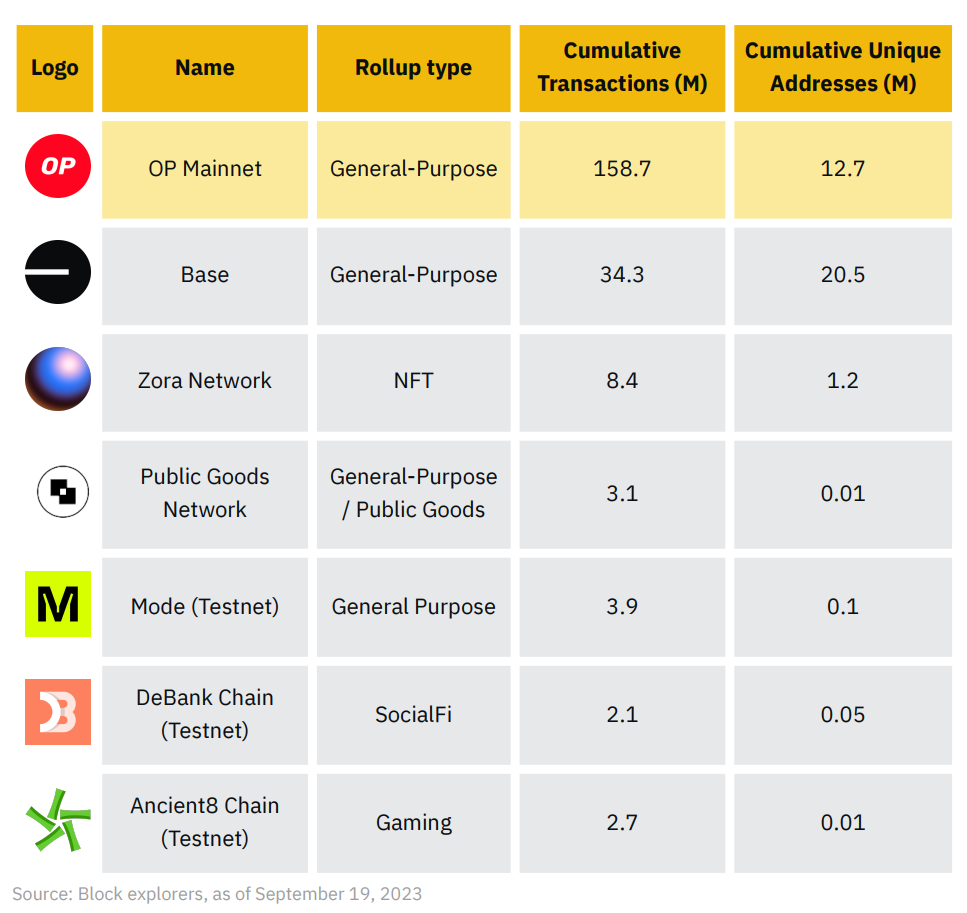
(1) Notable Projects
- Base
Base is one of the first OP Stack L2s announced (initially in February 2023) and launched its public mainnet on August 9. Base is a general-purpose L2 and is the most popular OP Stack chain after the OP mainnet.
Onchain Summer was a month-long release event that coincided with Base's launch, attracting multiple partners, including Coca-Cola, which co-launched an NFT Mint. This event attracted over 268,000 unique wallets from 75 unique collections, generating over 700,000 mints. The close association with Coinbase has allowed Base to integrate multiple features, providing easy access for Coinbase users. Base has also launched over 100 dApps, and its ecosystem is continually growing.
Additionally, friend.tech is a highly regarded SocialFi platform that allows users to trade tokenized "keys," attracting a large number of users and transaction volume. However, it is still in the testing phase, and future growth may require attracting non-crypto and Web2 users.
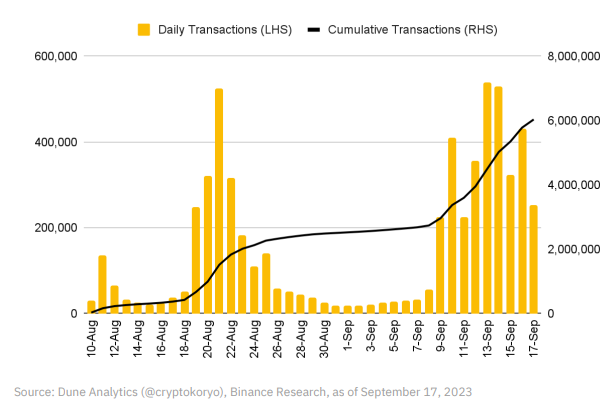
After an initial surge in mid-August, daily transactions for friend.tech noticeably slowed down until they picked up again in recent weeks.
The Base ecosystem fund, led by Coinbase Ventures, focuses on supporting early projects, including DeFi, fiat on/off-ramps, and creator platforms. Furthermore, the Base team released Pessimism, an open-source monitoring system aimed at enhancing the security of the OP Stack and other EVM-compatible chains, focusing on detecting protocol threats and mitigating security risks.
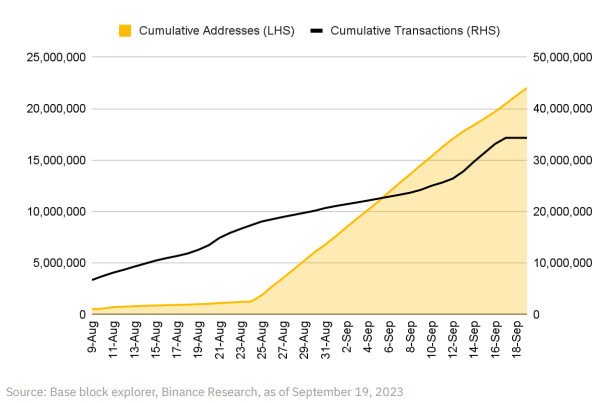
Since launching the mainnet in early August, Base's user metrics have seen significant growth throughout September.
Based on the collaboration between Optimism and Base, they have reached an economic agreement where Base will donate 2.5% of sequencer total revenue or 15% of net profits to Optimism, with the opportunity to earn up to $118 million in OP Tokens over the next six years. Although not explicitly announced, other OP Stack chains may also have similar revenue-sharing agreements with Optimism, highlighting the importance of collective contributions to the Superchain's infrastructure.
- Zora Network
Zora Network is a decentralized, permissionless protocol that allows anyone to buy, sell, and create NFTs. Additionally, they launched their own OP Stack Layer 2 network to support users and reduce platform costs.
They launched their mainnet on June 21, 2022, providing a better user experience for NFT transactions, as the cost of creating NFTs is less than $0.50 and offers many free minting options. Compared to Ethereum, the inter-block time on the OP Stack is only 2 seconds, allowing Zora Network transactions to be confirmed within seconds.
Moreover, Zora Network successfully completed three rounds of financing, raising a total of $60 million, including a $50 million round led by Haun Ventures in 2022, which valued the company at $600 million. This funding will help drive Zora Network's growth and development in the NFT space.
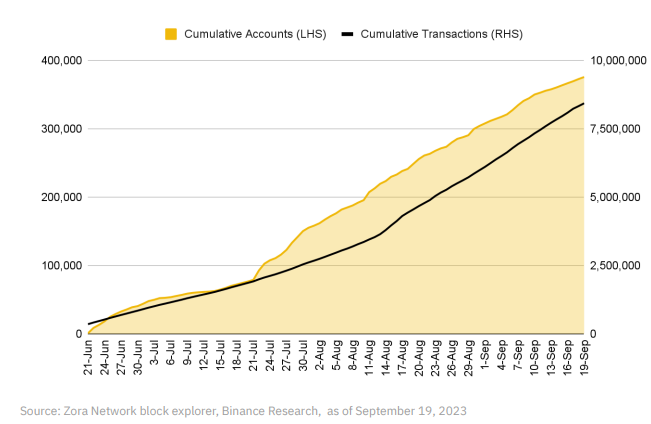
Since late July, Zora's user metrics have been steadily increasing.
- Public Goods Network
Public Goods Network (PGN) is an L2 protocol designed specifically to support public goods. Public goods refer to non-excludable and non-competitive products or services, such as parks, libraries, and road infrastructure, which in the digital realm can include open-source software, permissionless data, and AI models. The development of PGN is led by Gitcoin and SuperModular, supported by several public goods advocates, forming a public goods coalition responsible for the governance and organization of PGN.
How PGN Works: PGN's documentation indicates that the vast majority of net sequencing fees will be used to support public goods projects, so as activity on L2 increases, funding for public welfare projects will also increase. PGN aims to attract various types of dApps to deploy on its L2, not limited to projects related to public goods. PGN plans to evaluate its fees and allocate them to public goods projects within six months before January 2024, with more details to be announced in the coming weeks.
Additionally, PGN plans to utilize Contractual Security Revenue (CSR) after October 2023, which will allow developers to collect a percentage of fees from transactions generated by their contracts and support them in creating sustainable business models. CSR may become part of a broader L2 network, and there have even been Ethereum Improvement Proposals (EIPs) suggesting the introduction of CSR on EVM's L2.
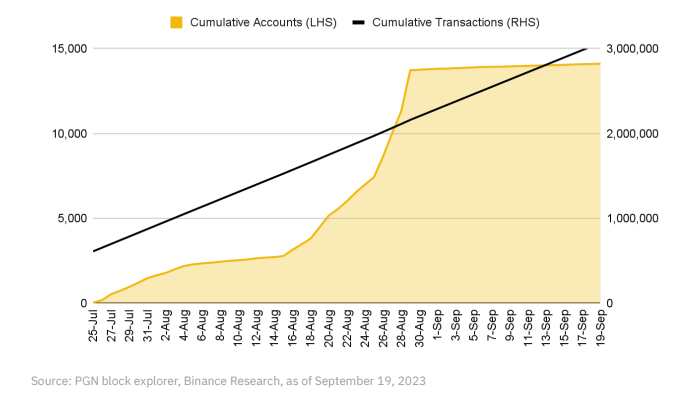
PGN's user metrics have steadily increased in August. Although new accounts slowed down in September, transactions continue to rise.
- Mode
Mode is positioned to support rapidly growing L2 networks and empower users and developers to build world-class applications and scale ecosystems through direct rewards. Revenue sharing incentives play a key role in achieving this goal.
Running an L2 network requires maintaining a sequencer, which is responsible for ordering, processing, and passing L2 transactions to the L1 main chain. Typically, the transaction fees paid by users are owned by the DAO or the sequencer operating company. Mode aims to distribute these sequencing fees to the developers and users of the network, rather than to the company.
Developers based on Mode will receive a portion of Mode's sequencer revenue, depending on the transaction fees charged in their deployed contracts. These fees are paid in USD and settled bi-weekly. This approach allows developers to be directly rewarded for their work, helping to establish predictable and scalable Web3 business models.
Mode encourages users, developers, and protocols to refer new members to share a portion of transaction fee revenue. They also provide support for developers building applications and offer integrated development tools. Mode is developing a developer dashboard to provide key metrics and insights to help developers scale more easily. They also plan to integrate multiple external tools and services to assist developers in building sustainable businesses. Finally, Mode adopts a governance-minimized approach, requiring the DAO to vote on only a few key issues, including how to allocate sequencing fee revenue.
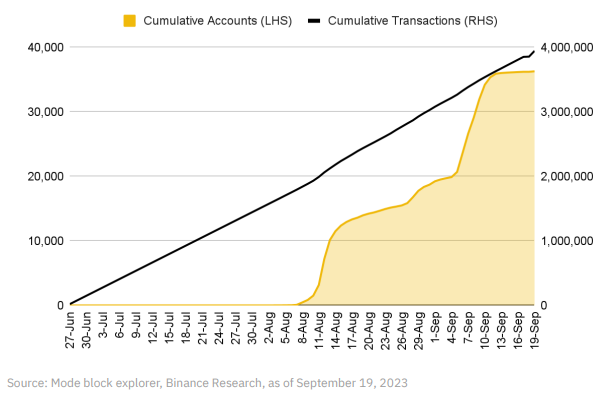
Mode is approaching 4 million transactions, with over 36,000 unique accounts.
Mode is currently in a public testnet, expected to last until the end of September. The mainnet is anticipated to launch in the fourth quarter of 2023.
- DeBank
DeBank is a Web3 portfolio tracking protocol that offers a variety of products, including portfolio tracking systems, social networking services, and NFTs. DeBank Chain is their testnet for an L2 chain based on the OP Stack, expected to launch in 2024.
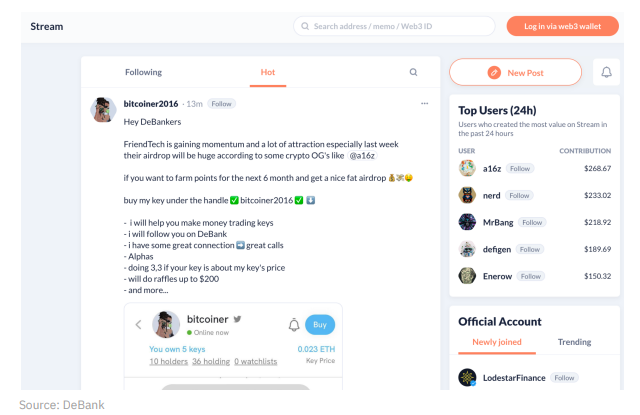
The core goal of DeBank Chain is to reduce the transaction costs of user interactions within the DeBank ecosystem. By modifying the consensus mechanism, they successfully lowered the gas costs of individual transactions to better meet the demands of high-frequency social interactions. Additionally, DeBank Chain features directly built-in account abstraction capabilities while also generating protocol revenue. Since launching the testnet on August 11, DeBank Chain has recorded over 2.1 million transactions, covering over 50,000 unique wallet addresses. Furthermore, DeBank has attracted over 250,000 registered users.
- Ancient8 and Ancient8 Chain
Ancient8 has operated as a gaming guild and aims to help gamers enter the Web3 world through partnerships with over 100 games. They introduced Ancient8 Chain, an Ethereum L2 series focused on gaming. The testnet for this chain was launched on September 15. Ancient8's vision is to build a complete gaming ecosystem, including NFT sales, game community building, game identity and credential creation, and project marketing. They also established the Ancient8 Collective, composed of eight core partners, to collaboratively build the Ancient8 chain ecosystem. This project has raised $10 million in funding.
Although the testnet for Ancient8 Chain has only been launched for a few days, it has already recorded over 2 million transactions involving nearly 5,000 unique accounts. These statistics indicate the popularity and growth momentum of Ancient8 Chain in the Web3 gaming space.
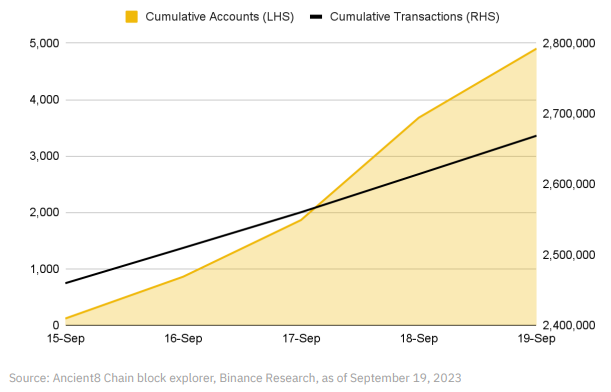
The testnet for Ancient8 Chain is still in its early stages.
(2) Infrastructure
- Conduit
Conduit is a rollup-as-a-service ("RaaS") platform that allows developers to easily launch their own OP Stack rollups. The Conduit team operates and maintains the rollups so that developers can focus on building products rather than handling infrastructure.
Since launching the mainnet in March 2023, many different OP Stack chains, including Zora Network, Public Goods Network, Ancient8 Chain, and Mode, have chosen to partner with Conduit to launch their products.
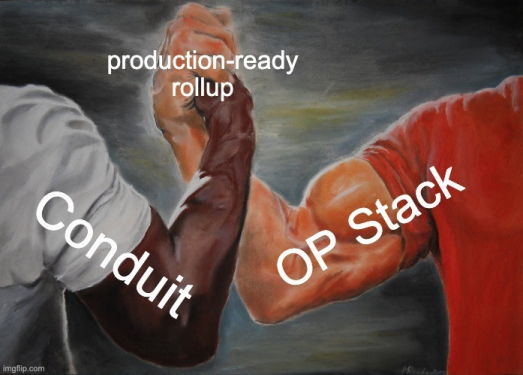
Conduit is a solution that helps easily launch and manage OP Stack L2 Rollups. Developers can create their own L2 in minutes, including block explorers, transaction trackers, and auto-scaling RPCs. Additionally, Conduit automatically updates each partner's L2 and integrates with the Optimism Superchain, while also supporting the Optimism Public Goods Fund with a portion of the fees.
Conduit's integration allows partners to connect to other infrastructure projects, such as Zora Network and Axelar, enhancing Conduit's integrated infrastructure and making rollups easier to scale their user base.
Conduit has raised $7 million in seed funding, led by Paradigm.
- AltLayer
AltLayer is a RaaS protocol that allows developers to launch Optimism Rollups. It supports a multi-chain and multi-VM world, including EVM, WASM, Solana VM, and Move VM. Unlike Conduit, AltLayer supports various software development platforms. AltLayer is currently in the testnet phase.
AltLayer's products include a no-code dashboard that allows users to create custom L2 Rollups in minutes, as well as a Rollup SDK for developers looking to integrate Rollup services directly into their products. AltLayer also provides a shared sequencer set, enabling cross-chain atomic transactions and messaging with other L2s launched with AltLayer.
AltLayer offers a core network called the Beacon Layer, serving as an intermediary layer between the execution layer and data availability layer of L2s. The Beacon Layer supports various rollup SDKs, data availability solutions, sequencer sets, and interoperability platforms, increasing the flexibility and interoperability of rollups.
The Flash Layer is a one-time application-specific rollup, very useful for high-traffic events like NFT mints, mini-games, etc. AltLayer also offers standard Optimism Rollups as part of its platform, more suitable for long-term applications like GameFi and SocialFi.
AltLayer raised $7.2 million in seed funding in 2022, led by Polychain Capital.
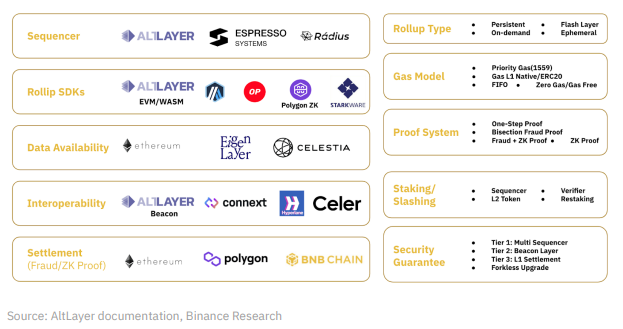
AltLayer's universal Rollup OP Stack supports multiple protocols.
Conclusion
We are witnessing a surge of various computation stack chains, including general-purpose L2s like Base and Mode, as well as specialized chains like Zora Network, DeBank Chain, and Ancient8 Chain.
New features like Conduit integration are simplifying the deployment and scaling of OP Stack Rollups, providing possibilities for more L2 Rollups based on this stack. The uniqueness of Conduit in conjunction with the OP Stack raises an interesting development regarding whether to use dedicated RaaS providers to grow the ecosystem compared to competing L2/L3 frameworks like Arbitrum's Orbit or zkSync's ZK Stack.
Ethereum Rollup metrics continue to break historical records, with more dApps deciding to deploy on L2 rather than L1, signaling the imminent arrival of the L2 Rollup era. EIP-4844, or Proto-Danksharding, is expected to significantly reduce L2 Rollup costs and enhance their competitiveness. The high utilization of L2s, the convenient deployment of infrastructure like OP Stack and Conduit, and the prospects of EIP-4844 will further drive the development of L2s. We look forward to how future developments will unfold.






